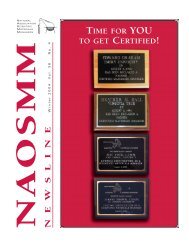Laboratory Safety Guidance
OSHA Lab Safety Guidance - ORS Optical Remote Sensing ...
OSHA Lab Safety Guidance - ORS Optical Remote Sensing ...
- No tags were found...
You also want an ePaper? Increase the reach of your titles
YUMPU automatically turns print PDFs into web optimized ePapers that Google loves.
working with captured animals is the development<br />
of an allergy. The development of disease in the<br />
human host often requires a preexisting state that<br />
compromises the immune system. Workers who<br />
have an immune compromising medical condition<br />
or who are taking medications that impair the<br />
immune system (steroids, immunosuppressive<br />
drugs, or chemotherapy) are at higher risk for contracting<br />
a rodent disease.<br />
Wild rodents may act as carriers for viruses such as<br />
Hantavirus and lymphocytic choriomeningitis virus<br />
(LCMV) depending on where they were captured.<br />
Additionally, each rodent species may harbor their<br />
own range of bacterial diseases, such as tularemia<br />
and plague. These animals may also have biting<br />
insect vectors which can act as a potential carrier of<br />
disease (mouse to human transmission).<br />
Examples of zoonotic diseases that can be transmitted<br />
from wild and domesticated animals to humans<br />
are listed in the table at page 45 in the Appendix.<br />
Zoonotic Diseases – Non-human Primates<br />
(e.g., monkeys)<br />
It should not be surprising that, given our many<br />
similarities, humans and non-human primates are<br />
susceptible to similar infectious agents. Because of<br />
our differences, the consequences of infection with<br />
the same agent often vary considerably. Infection<br />
may cause few if any symptoms in one group and<br />
may be lethal to the other. Exposures to body fluids<br />
from non-human primates should be treated immediately.<br />
In 2003, a report entitled, Occupational <strong>Safety</strong> and<br />
Health in the Care and Use of Non-Human Primates<br />
(see References) was published. This report covers<br />
topics relevant to facilities in which non-human primates<br />
are housed or where non-human primate<br />
blood or tissues are handled. The report describes<br />
the hazards associated with work involving nonhuman<br />
primates and discusses the components of a<br />
successful occupational health and safety program,<br />
including hazard identification, risk assessment and<br />
management, institutional management of workers<br />
after a suspected occupational exposure, applicable<br />
safety regulations, and personnel training.<br />
Employers should ensure that workers are trained<br />
to adhere to the following good practices to prevent<br />
exposure to zoonotic diseases when working with<br />
research animals:<br />
• Avoid use of sharps whenever possible. Take<br />
extreme care when using a needle and syringe<br />
to inject research animals or when using sharps<br />
during necropsy procedures. Never remove,<br />
recap, bend, break, or clip used needles from<br />
disposable syringes. Use safety engineered needles<br />
when practical.<br />
• Take extra precautions when handling hoofed<br />
animals. Due to the physical hazards of weight<br />
and strength of the animal, large hoofed mammals<br />
pose additional concerns for workers.<br />
Hoofed mammals may resist handling and may<br />
require multiple workers to administer medication<br />
or perform other functions.<br />
• Keep hands away from mouth, nose and eyes.<br />
• Wear appropriate PPE (i.e., gloves, gowns, face<br />
protection) in all areas within the animal facility.<br />
■ A safety specialist may recommend additional<br />
precautions, based upon a risk assessment of<br />
the work performed.<br />
• Wear tear-resistant gloves to prevent exposure<br />
by animal bites. Micro-tears in the gloves may<br />
compromise the protection they offer.<br />
• Remove gloves and wash hands after handling<br />
animals or tissues derived from them and before<br />
leaving areas where animals are kept.<br />
• Use mechanical pipetting devices (no mouth<br />
pipetting).<br />
• Never eat, drink, smoke, handle contact lenses,<br />
apply cosmetics, or take or apply medicine in<br />
areas where research animals are kept.<br />
• Perform procedures carefully to reduce the<br />
possibility of creating splashes or aerosols.<br />
• Contain operations that generate hazardous<br />
aerosols in BSCs or other ventilated enclosures,<br />
such as animal bedding dump stations.<br />
• Wear eye protection.<br />
• Wear head/hair covering to protect against<br />
sprays or splashes of potentially infectious fluids.<br />
• Keep doors closed to rooms where research<br />
animals are kept.<br />
• Clean all spills immediately.<br />
• Report all incidents and equipment malfunctions<br />
to the supervisor.<br />
• Promptly decontaminate work surfaces when<br />
procedures are completed and after surfaces are<br />
soiled by spills of animal material or waste.<br />
• Properly dispose of animal waste and bedding.<br />
• Workers should report all work-related injuries<br />
and illnesses to their supervisor immediately.<br />
• Following a bite by an animal or other injury in<br />
which the wound may be contaminated, first aid<br />
should be initiated at the work site.<br />
2 0<br />
Occupational <strong>Safety</strong> and<br />
Health Administration



